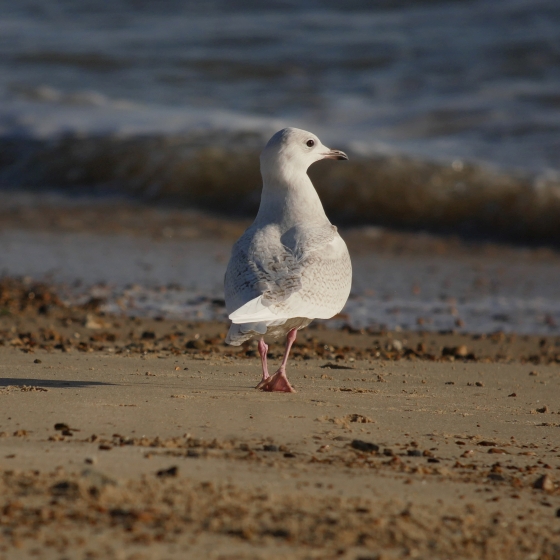Iceland Gull

Introduction
Iceland Gull is a gentle-looking bird with a neat round head and large eyes that add to this effect.
Iceland Gulls breed along rocky coasts, from Greenland west to north-east Canada. After the breeding season young birds disperse from their breeding grounds with many heading south and west, arriving in Iceland during September. During the winter months a few birds will head further south and those reaching Britain & Ireland arrive early in the winter.
Iceland Gull is a scarce winter visitor to Britain & Ireland. In some years fewer than one hundred birds occur; in other years several hundred are reported.

Key Stats
Identification
ID Videos
This section features BTO training videos headlining this species, or featuring it as a potential confusion species.
Iceland and Glaucous Gull
Status and Trends
Conservation Status
Population Size
Population Change
Iceland Gull is a scarce, but regular, visitor to the UK and is found in both coastal and inland locations. Numbers in the UK are normally low, but subject to occasional large influxes, such as the one in January / February 2012 during which unusually high numbers were seen in the Northern and Western Isles of Scotland Fray et al. 2012]. Numbers of Iceland Gulls observed during [WeBS counts are not sufficient to allow trend data to be produced for this species.
Distribution
Iceland Gulls are scarce but regular passage migrants and winter visitors They arrive from autumn into northern and western Britain & Ireland and then move south as the winter progresses. Although there are hot spots around fish quays, harbours and landfill sites, they can be found by carefully searching gull flocks at loafing and roost sites. They are scattered around the coast of Britain with concentrations evident in west Cornwall, northeast and northwest England, Caithness, the Northern Isles and the Outer Hebrides. There are records from many inland locations, particularly in central England where the gull roosts are well watched. In Ireland the distribution is predominantly coastal.
Occupied 10-km squares in UK
2007/08–10/11
or view it on Bird Atlas Mapstore.
2008–11
or view it on Bird Atlas Mapstore.
European Distribution Map
Distribution Change
Change in occupied 10-km squares in the UK
from 1981–84 to 2007–11
or view it on Bird Atlas Mapstore.
Seasonality
Iceland Gulls are usually winter visitors, most often recorded in late winter.
Weekly pattern of occurrence
The graph shows when the species is present in the UK, with taller bars indicating a higher likelihood of encountering the species in appropriate regions and habitats.

Movement
Britain & Ireland movement
Foreign locations of birds ringed or recovered in Britain & Ireland
Dots show the foreign destinations of birds ringed in Britain & Ireland, and the origins of birds ringed overseas that were subsequently recaptured, resighted or found dead in Britain & Ireland. Dot colours indicate the time of year that the species was present at the location.
- Winter (Nov-Feb)
- Spring (Mar-Apr)
- Summer (May-Jul)
- Autumn (Aug-Oct)

Biology
Survival and Longevity
Survival is shown as the proportion of birds surviving from one year to the next and is derived from bird ringing data. It can also be used to estimate how long birds typically live.
View number ringed each year in the Online Ringing Report.
Classification, names and codes
Classification and Codes
- Order: Charadriiformes
- Family: Laridae
- Scientific name: Larus glaucoides
- Authority: B Meyer, 1822
- BTO 2-letter code: IG
- BTO 5-letter code: ICEGU
- Euring code number: 5980
Alternate species names
- Catalan: gavinot polar
- Czech: racek polární
- Danish: Hvidvinget Måge
- Dutch: Kleine Burgemeester
- Estonian: polaarkajakas
- Finnish: grönlanninlokki
- French: Goéland arctique
- Gaelic: Faoileag-liath
- German: Polarmöwe
- Hungarian: sarki sirály
- Icelandic: Bjartmáfur
- Irish: Faoileán Íoslannach
- Italian: Gabbiano d'Islanda
- Latvian: maza polarkaija
- Lithuanian: mažasis poliarinis kiras
- Norwegian: Grønlandsmåke
- Polish: mewa polarna
- Portuguese: gaivota-branca
- Slovak: cajka bielokrídla
- Slovenian: polarni galeb
- Spanish: Gaviota groenlandesa
- Swedish: vitvingad trut
- Welsh: Gwylan yr Arctig
Research
Causes of Change and Solutions
Causes of change
The European population trend for Iceland Gull is stable [BirdLife International 2018] and drivers of population change are unknown.
More Evidence
More evidence from Conservation Evidence.com
Partners
Citing BirdFacts
If you wish to cite particular content in this page (e.g. a specific value) it is best to use the original sources as linked in the page. For a more general citation of the whole page please use: BTO (20XX) BirdFacts Species: profiles of birds occurring in the United Kingdom. BTO, Thetford (www.bto.org/birdfacts, accessed on xx/xx/xxxx).

